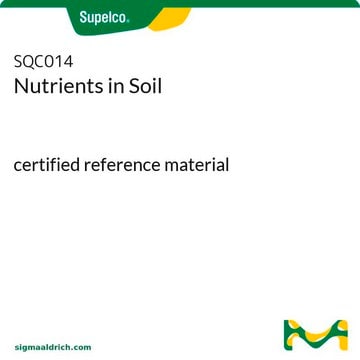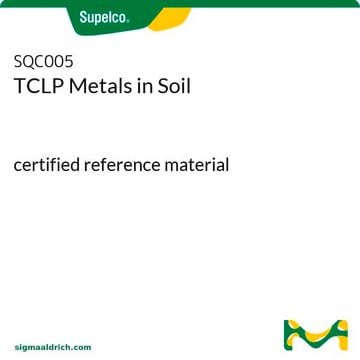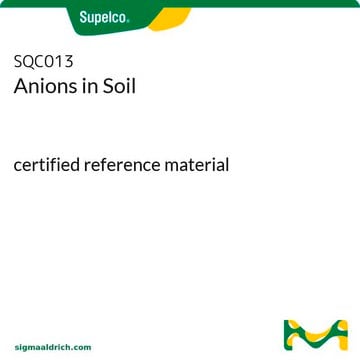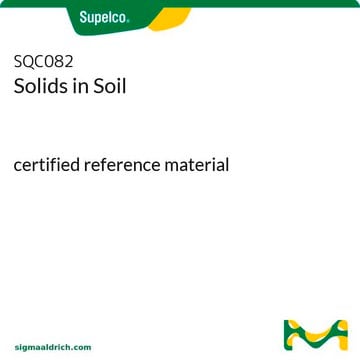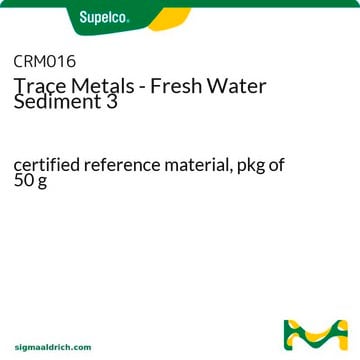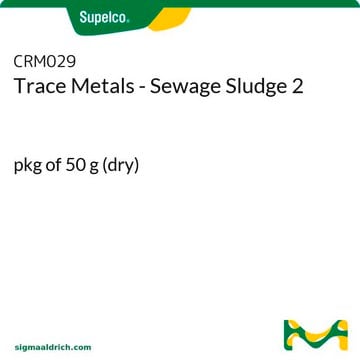SQC001
Metalle im Boden
certified reference material
Synonym(e):
Soil matrix CRM, heavy metals
Anmeldenzur Ansicht organisationsspezifischer und vertraglich vereinbarter Preise
Alle Fotos(1)
About This Item
UNSPSC-Code:
41116107
NACRES:
NA.24
Empfohlene Produkte
Qualität
certified reference material
Analysenzertifikat (CofA)
current certificate can be downloaded
Hersteller/Markenname
RTC SQC-001
Methode(n)
AAS: suitable
ICP: suitable
Matrix
soil
Anwendung(en)
environmental
Format
matrix material
Lagertemp.
2-30°C
Verwandte Kategorien
Allgemeine Beschreibung
This Certified Reference Material (CRM) is produced and certified in accordance with ISO 17034 and ISO/IEC 17025. All information regarding the use of this CRM can be found on the certificate of analysis.
Sonstige Hinweise
Die Werte der Analyten sind Lot-spezifisch.
Signalwort
Danger
H-Sätze
WGK
WGK 3
Flammpunkt (°F)
Not applicable
Flammpunkt (°C)
Not applicable
Choose from one of the most recent versions:
Besitzen Sie dieses Produkt bereits?
In der Dokumentenbibliothek finden Sie die Dokumentation zu den Produkten, die Sie kürzlich erworben haben.
Xiaowen Ji et al.
Journal of hazardous materials, 408, 124430-124430 (2020-11-13)
A 180-day incubation study was conducted to evaluate the effects of risk elements (REs) on organic carbon use and microbial activities in organic soils in the Arctic during the summer snowmelt period. Soils were artificially spiked with Cd, Pb, Cr
Xiaowen Ji et al.
Archives of environmental contamination and toxicology, 76(4), 540-553 (2019-02-24)
Permafrost-affected region in Russian Arctic is an important study area for investigating fate of trace metals in soils by geological processes and human-induced trace metals through atmospheric deposition. Two plots of soils in Yamal region were selected: Northern Trans-Urals area
Rezvan Davodpour et al.
Archives of environmental contamination and toxicology, 77(3), 344-358 (2019-04-26)
Honeybees, due to their wide-ranging foraging behaviour, have great potentials for monitoring environmental quality. Therefore, the purpose of this study was to use honeybees as bioindicators for the detection of toxic and essential metals (Cd, Cr, Cu, and Fe) in
Unser Team von Wissenschaftlern verfügt über Erfahrung in allen Forschungsbereichen einschließlich Life Science, Materialwissenschaften, chemischer Synthese, Chromatographie, Analytik und vielen mehr..
Setzen Sie sich mit dem technischen Dienst in Verbindung.